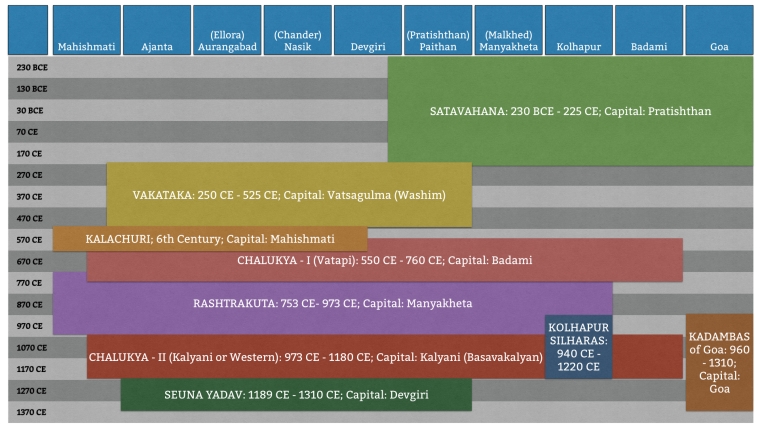An overview of the various dynasties that ruled the region that is now Maharashtra, from 230 BCE – 1300 CE. A very short description of all these dynasties follows.
We are very grateful to Brigadier Gerard, who had first posted this as a sketch on Twitter, and gave us permission adapt it and post it here.

The Dynasties of Maharashtra
Most of the content below is sourced from Wikipedia. Apart from this, some references have been made to various books listed at the end.
A note on dates: You will notice some discrepancies in the dates in the infographic above and sources (including Wikipedia). This is primarily due to how historians interpret dates. Some take it starting from when a dynasty was established, some take it at later time. Most of the dynasties listed below were vassals or feudatories of the dynasties that preceded them. In such situations, they were semi-independent to an extent.
Sātavāhan
The Satavahana dynasty ruled the Deccan region between 230 BCE – 225 CE. They were probably vassals of the Mauryas, and established their supremacy in the Deccan after the decline of the Maurya Empire. The dynasty was established by Simuka, however, Gautamiputra Satakarni (86–110 CE) is the most well-known king of this dynasty. The Satavahanas ruled from Pratishthana (modern-day Paithan) and Amravati (Dist. Guntur, Andhra Pradesh) [Link]
Vākāṭaka
The Satavahanas were succeeded by the Vakatakas, who ruled during 250 – 525 CE, with their capital at Nandivardhana (modern-day Nandardhan, near Ramtek) and Vatsagulma (modern-day Washim). This dynasty was founded by Vindhyashakti (c. 250 – c. 270 CE). Vakatakas are known for their patronage of art & architecture. The famous Ajanta caves, were built by under the patronage of Vakataka emperor, Harishena. [Link]
Kālāchuri
The Kalachuri dynasty, ruled in Ujjayini, Vidisha, and Anandapura; and their capital was Mahishmati, which lies along the banks of the Narmada River. Not much is known about the founder of this dynasty; the earliest mentioned king was called Krishnaraja. Like the Vakatakas, the Kalachuris were also patrons of art & architecture. The Elephanta caves and the early Ellora caves were built under their patronage. [Link]
Chalukyas of Vatapi (Badami)
One of the most significant dynasties of the Deccan, the early Chalukyas, or the Chalukyas of Vatapi ruled a large area of the Deccan between 550 – 760 CE, covering the entire region between the Narmada and the Kaveri rivers. Their rule is considered to be an era of prosperity. It also saw the birth of a new architectural style called Chalukyan architecture. The Chalukyas were natives of Karnataka; this dynasty was founded by Pulakeshin I. [Link]
Rāṣṭrakūṭa
The Rashtrakuta dynasty ruled most of the Indian subcontinent, between 753 – 973 CE, with their capital at Manyakheta (Modern-day Malkhed). The Rashtrakutas were feudatories of the Chalukyas of Vatapi and at peak, the Rashtrakutas ruled from the Ganges River to Cape Comorin. This period saw the development of many literary works as well as development of architecture, which include the Kailashnath temple at Ellora and the Jain Narayana Temple at Pattadakal. [Link]
Śilāhāra
The Silahara were vassals of the Rashtrakutas and were split in three branches: North Konkan, South Konkan, and Kolhapur. Across these three branches, the Silaharas ruled between 765 – 1215 CE. The Northern branch was founded by Kapardin, and their capital was Puri (modern-day Rajapur, in the Raigad district). The Silaharas of Kolhapur originally ruled from Karad, and later shifted their capital to Kolhapur. The Panhala fort, near Kolhapur was originally built by the Silahara ruler, Bhoja II between 1178 and 1209 CE. [Link]
Chalukyas of Kalyani
The Chalukyas of Kalyani, or the Western Chalukyas, ruled the Indian subcontinent during 973 CE – 1180 CE, with their capital, earlier at Manyakheta, and later at Kalyani (modern-day Basavakalyan). Major ruling families of the Deccan, the Hoysalas, the Seuna Yadavas of Devagiri, the Kakatiya dynasty and the Southern Kalachuris of Kalyani, were subordinates of the Western Chalukyas. The Western Chalukyan architectural style is well known as the transitional style between the earlier Chalukyas and the Hoysalas. [Link]
Kadamba
The Kadamba dynasty ruled northern Karnataka and the Konkan from Banavasi. The dynasty was founded by Mayurasharma in 345 CE. Kadambas were the first rulers to use Kannada as another official administrative language. The Kadambas of Goa, first ruled from Chandor, and laters shifted their capital to Gopakapattana (Goa). The Kadambas of Goa ruled between 960 – 1310 CE and succumbed to the Seuna Yadavs. [Link]
Seuna Yadav
The Seuna Yadavs were feudatories of the Western Chalukyas, and established their independence as the Chalukyan power declined. The Yadavas of Devgiris, as they are also known, ruled from 1189 – 1310 CE, from Devgiri (modern-day Daulatabad). The name Seuna comes from Seunachandra, who originally ruled a region called Seunadesha (modern-day Khandesh), this dynasty was established by Bhillama V (1173–1192 CE). Singhana II (1200–1247 CE), however is considered the greatest ruler of this dynasty who expanded the Seuna kingdom. In 1317 CE, this kingdom was annexed by the Khilji Sultanate. [Link]
References
- A., N. S. (1976). A history of South India from prehistoric times to the fall of Vijayanagar. Madras: Oxford University Press.
- Bhāndārkar, R. G. (1957). Early History of the Dekkan. Calcutta: Gupta.
- Nagpur District Gazetteer. (n.d.). Retrieved January 07, 2017, from https://web.archive.org/web/20060603010304/http://www.maharashtra.gov.in/english/gazetteer/FINAL_GAZETTEE/his1.html
- Sharma, L. P. (1987). History of Ancient India: (pre-historic age to 1200 A.D.). New Delhi: Konark .
- Singh, U. (2008). A history of ancient and early medieval India: from the Stone Age to the 12th century. New Delhi: Pearson Education.
Featured Image: By Dey.sandip (Own work) [CC BY-SA 3.0], via Wikimedia Commons
